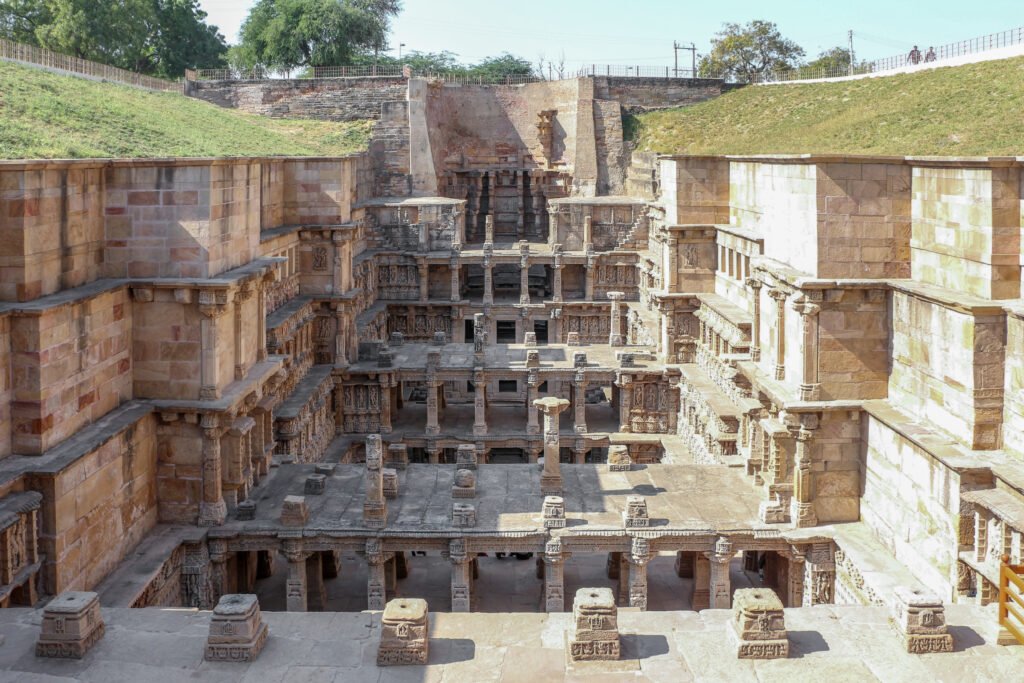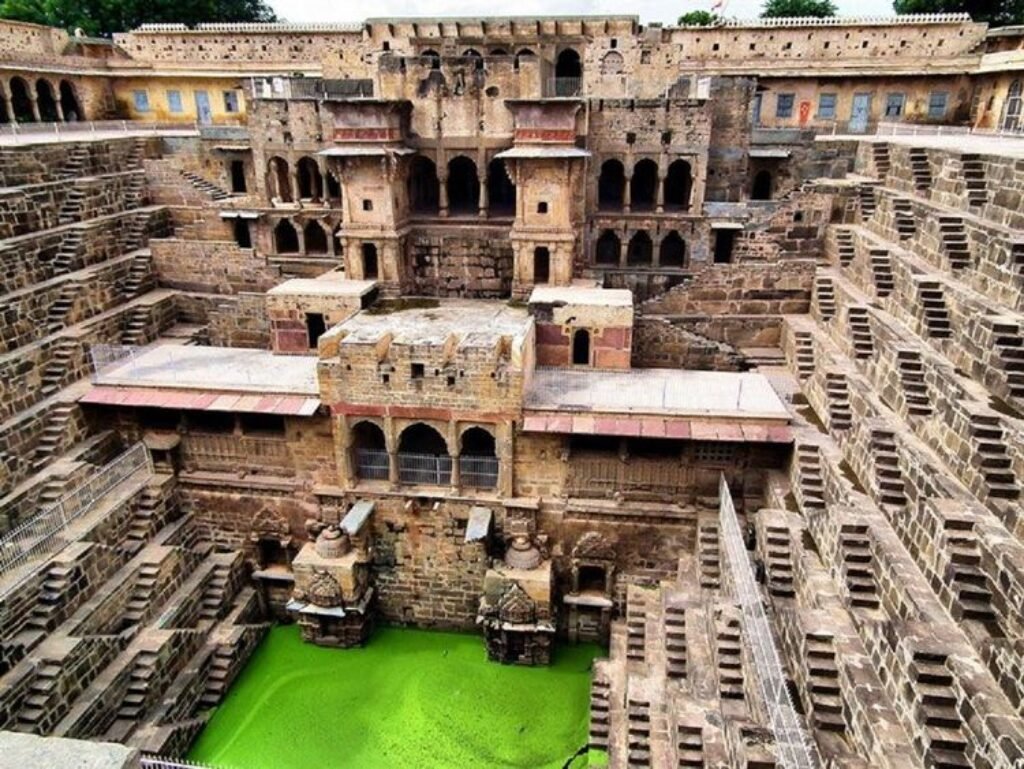
GujaratTop પર આપનું સ્વાગત છે. આ બ્લોગમાં આપણે રાણી કી વાવ વિશે વાત કરીશું. ગુજરાતના પાટણમાં સ્થિત રાણી કી વાવ એ ભારતના સૌથી પ્રભાવશાળી અને ઐતિહાસિક રીતે મહત્વપૂર્ણ વાવમાંથી એક છે જેને યુનેસ્કો દ્વારા વિશ્વ ધરોહર સ્થળ તરીકે નિયુક્ત કરવામાં આવ્યો છે.
ક્વીન્સ સ્ટેપવેલ તરીકે પ્રખ્યાત, અંડાકાર કૂવો એ ભારતે અત્યાર સુધીમાં બનાવેલ સૌથી ભવ્ય સ્થાપત્ય છે, જે એક જ છત નીચે પ્રાચીન ઇજનેરી અને કલાત્મકતાનું ભવ્ય ઉદાહરણ છે. આ ઈમારતની સ્થાપના 11મી સદીમાં સોલંકી કુળના રાજા ભીમદેવ પ્રથમની પત્ની રાણી ઉદયમતીના સૌજન્યથી કરવામાં આવી હતી અને તે પેઢીઓથી અનુસરવામાં આવતી સાંસ્કૃતિક પરંપરાનું પ્રકટીકરણ છે.
Table of Contents
ઐતિહાસિક પૃષ્ઠભૂમિઃ
ભીમદેવ પ્રથમના શાસન દરમિયાન ઈ. સ. 1050ની આસપાસ બાંધવામાં આવેલી રાણી કી વાવનું નિર્માણ રાજા ભીમદેવ પ્રથમ દ્વારા કરવામાં આવ્યું હતું અને એવું કહેવાય છે કે તેનું નિર્માણ રાણી ઉદયમતી દ્વારા તેમના પતિની યાદમાં કરવામાં આવ્યું હતું. તેનું નિર્માણ માત્ર પાણીના સંગ્રહ માટે જ નહીં પરંતુ રાજાના સન્માનમાં એક વિશાળ સ્મારક તરીકે પણ કરવામાં આવ્યું હતું. તેની સમૃદ્ધિ અને સાંસ્કૃતિક મહત્વ માટે જાણીતું મધ્યયુગીન ભારતીય શહેર પાટણમાં સરસ્વતી નદીના કાંઠે સ્થિત આ વાવ છે.
19મી સદીની શરૂઆતમાં સરસ્વતી નદીના પૂરને કારણે આ વાવ ટન ટન કાદવ હેઠળ દબાઈ ગઈ હતી. સદીઓથી ભૂલી ગયેલી અને પૃથ્વીની વચ્ચે ગંદકીના સ્તરોમાં પડેલી, તેની સ્થાપત્ય અને કલાત્મક ભવ્યતા જાહેર કરવાની નથી. 19મી સદીના અંતમાં જ્યારે આ નોંધપાત્ર વારસાને ખોદવા અને પુનઃસ્થાપિત કરવાનો પ્રયાસ શરૂ કરવામાં આવ્યો ત્યારે તેની પુનઃશોધ ન થઈ ત્યાં સુધી વાવ લગભગ ભૂલી જવામાં આવી હતી.

સ્થાપત્ય લક્ષણોઃ
રાણી કી વાવની ભવ્યતાને સમજો, જે પ્રાચીન ભારતની લલિત કલા અને ઇજનેરી કુશળતાનો મહત્વનો વારસો છે. આધ્યાત્મિક જગતમાં સામગ્રીના માર્ગનું પ્રતિનિધિત્વ કરતા ઊંધા મંદિર તરીકે રચાયેલ, બહુમાળી વાવમાં વિસ્તૃત બહુમાળી પગથિયાં, સ્તંભવાળા કોરિડોર અને સ્ત્રી દેવતાઓના શિલ્પો સહિત ઉત્કૃષ્ટ કોતરણીવાળા પથ્થરો છે.
આ બાવડીમાં સાત માળ છે અને તેમાં ભૌમિતિક રચનાઓ અને પ્રતીકાત્મક કોતરણીઓ અને ધાર્મિક અને સાંસ્કૃતિક મહત્વ ધરાવતા શિલ્પોની વિસ્તૃત શ્રેણી છે. આ સીડીઓ પૃથ્વી પર દૂર એક જળાશય તરફ નીચે પડે છે જે વરસાદની ઋતુમાં ભરાઈ જતું હોત. તે માત્ર વરસાદી પાણીના સંગ્રહ માટેનું સ્થળ જ નથી, પરંતુ હજારો હિંદુ દેવી-દેવતાઓ, દૂતો અને પૌરાણિક પાત્રોની મૂર્તિઓ અને શિલ્પો સાથે એક પવિત્ર અને સુશોભન વિસ્તાર પણ છે.
વાવની દિવાલો અને સ્તંભો પર ભગવાન વિષ્ણુ, શિવ, લક્ષ્મી, ગંગા અને અન્ય દેવતાઓના શિલ્પો સાથે ખૂબ વિગતવાર શણગારવામાં આવ્યા છે. આ શિલ્પોમાં દેવી-દેવતાઓ, આકાશી પ્રાણીઓ અને ધાર્મિક વિધિઓમાં રોજિંદા જીવનની હસ્તીઓ, પ્રાણીઓ, નર્તકો, સંગીતકારો અને સૈનિકોના દ્રશ્યો દર્શાવવામાં આવ્યા છે. આ કોતરણીઓ સોલંકી રાજવંશ દરમિયાન પ્રાપ્ત ઉચ્ચ કારીગરી સ્તરનું ઉદાહરણ છે.
વધુ વાંચોઃ PAVAGADH
બાવડીની કેન્દ્રિય પેનલ વિષ્ણુ માટે છે, અને ટોચની આસપાસ રામાયણની દશાવતાર (વિષ્ણુના દસ અવતારોનું વર્ણન કરવાની વિભાવના) ઘટનાઓ તેમજ મહાભારતના ભાગો સહિત હિન્દુ પૌરાણિક કથાઓની ઘટનાઓની રાહત છે. પગથિયાંની વ્યવસ્થા એવી છે કે તે ગાણિતિક રીતે બનાવવામાં આવી હતી અને જ્યારે જરૂર પડે ત્યારે પાણી એકત્રિત કરવા માટે કોઈ પણ સમયે દૂર સુધી પહોંચતી ન હતી.
આ શૈલીનું એક ઉત્તમ ઉદાહરણ રાણી કી વાવ છે, જે એક ઊંડો વાવ છે, જેમાં ઊભી અને આડી જગ્યાઓનું અનોખું સંયોજન છે, જે ભારતીય-આર્યન ડિઝાઇનનું પ્રતિનિધિત્વ કરે છે. આ ઈમારતની અદભૂત બહુમાળી ડિઝાઇન અને કલાત્મક વિશેષતાઓએ ઈતિહાસકારો, આર્કિટેક્ટ્સ અને મુલાકાતીઓને પેઢીઓથી આશ્ચર્યચકિત કર્યા છે. વાવની કોતરણી અને એકંદર ડિઝાઇનમાં ખરાબ છતાં ભવ્ય ગુણવત્તા છે, તેથી જ તેને મધ્યયુગીન ભારતીય સ્થાપત્યની સૌથી મોટી શ્રેષ્ઠ કૃતિઓમાંની એક માનવામાં આવે છે.

ધાર્મિક અને સાંસ્કૃતિક મહત્વઃ
માત્ર જળ સંચય માળખું જ નહીં, રાની કી વાવ ધાર્મિક અને આધ્યાત્મિક મહત્વનું સ્થળ પણ હતું. ભગવાન વિષ્ણુ, ભગવાન શિવ, ગંગા અને લક્ષ્મી જેવા દેવતાઓની મૂર્તિઓ વાવની દિવાલો અને સ્તંભોને શણગારે છે, જે હિન્દુ ભક્તિ સંપ્રદાયમાં પાણી અને આધ્યાત્મિકતાનું મહત્વ સૂચવે છે.
આ વાવ પ્રાચીન ભારતીય સંસ્કૃતિ અને જીવન સાથે પાણીના સીધા સંબંધનું પણ પ્રતિનિધિત્વ કરે છે. ગુજરાત જેવા અર્ધ-શુષ્ક વિસ્તારમાં, વાવ તેમના તરસ, પેટ અને શરીરને ધોવા માટે અને ધાર્મિક પ્રવૃત્તિઓ માટે જીવનનો સ્રોત પૂરો પાડતો હોત. ધાર્મિક પ્રતીકો કોતરણીમાં સામાન્ય છે અને લોકો અને તેઓ જે સંસાધનો પર આધાર રાખતા હતા તે વચ્ચેના આધ્યાત્મિક બંધનને દર્શાવે છે.
રાની કી વાવનું નિર્માણ ભક્તિ અને સામાજિક સંવાદના સ્થળ તરીકે કરવામાં આવ્યું હતું. એક વાવ પાણી ખેંચવા, ધાર્મિક વિધિઓ અને ધ્યાન જેવી અન્ય પ્રવૃત્તિઓ માટે તેની આસપાસ ભેગા થવાની પણ મંજૂરી આપે છે. આ વાવ ચર્ચા, સામાજિકીકરણ અને પ્રાર્થના માટે જાહેર જગ્યા તરીકે કામ કરતી હતી. તે એક વ્યવહારુ જગ્યા કરતાં વધુ હતું, પરંતુ એક એવી જગ્યા હતી જ્યાં લોકોને ભગવાન સાથે તેમનો સંબંધ મળ્યો હતો.
વધુ જુઓઃ15th to 17th centuries, Historic City of Ahmedabad
પુનઃશોધ અને જાળવણીઃ
19મી સદીમાં ખોદકામ દરમિયાન, રાણી કી વાવ સદીઓની અસ્પષ્ટતામાંથી ખોદવામાં આવી હતી. ત્યારથી, સ્ટેપવેલ પુનઃસ્થાપન પ્રોજેક્ટ્સમાંથી પસાર થઈ છે જેણે આ સોફ્ટવેરમાં શક્ય તેટલી અખંડિતતા જાળવી રાખીને તેની મૂળ ભવ્યતા જાહેર કરવાનો પ્રયાસ કર્યો છે. આ બાવડી, તેની તમામ જટિલ કોતરણીઓ અને માળખા સાથે, આપણા ભારતીય પુરાતત્વ સર્વેક્ષણ (એએસઆઈ) એટિફ્સનો આભાર માનીને આવનારી પેઢીઓ સુધી સંરક્ષિત છે.
રાણી કી વાવ, 11મી સદીમાં બાંધવામાં આવેલી વાવ, 2014માં યુનેસ્કો દ્વારા વિશ્વ ધરોહર સ્થળ તરીકે સૂચિબદ્ધ કરવામાં આવી હતી અને તેને સાંસ્કૃતિક અને ઐતિહાસિક બંને મહત્વ ધરાવતા ભારતના શ્રેષ્ઠ સ્મારકોમાંના એક તરીકે ગણવામાં આવે છે. આ વાવને તેની સ્થાપત્ય પ્રતિભા, કલાત્મક ભવ્યતા અને ઐતિહાસિક મહત્વ માટે વિશ્વ ધરોહરની યાદીમાં સ્થાન મળ્યું છે.

પ્રવાસન અને સાંસ્કૃતિક અસરઃ
રાણી કી વાવ હવે એક મુખ્ય પ્રવાસન સ્થળ છે, અને વિશ્વભરના લોકો આ સ્થળની મુલાકાત લેવા આવે છે. તે હવે ગુજરાતમાં પ્રવાસન ક્ષેત્રનો એક મહત્વપૂર્ણ ઘટક બની ગયો છે, જે પ્રવાસીઓને આકર્ષે છે જેઓ હવે ઇતિહાસ, સંસ્કૃતિ, સ્થાપત્ય અને આધ્યાત્મિકતામાં પણ રસ ધરાવે છે. તે મુલાકાતીઓને પ્રાચીન ભારતની સ્થાપત્ય કુશળતા અને તેના પર વિચાર કરવા અને તેની સુંદરતાની પ્રશંસા કરવા માટે શાંતિપૂર્ણ લેન્ડસ્કેપ પ્રદાન કરે છે.
ઘણી કલાત્મક અને સાહિત્યિક કૃતિઓ પણ રાણી કી વાવથી પ્રેરિત છે, અને તે ગુજરાતના સમૃદ્ધ સાંસ્કૃતિક વારસાના પ્રતીક છે. આ પ્રસિદ્ધિએ ભારતના ઇતિહાસમાંથી એક પ્રતિષ્ઠિત પૃષ્ઠ તરીકે તેની સ્થિતિને મજબૂત કરવા માટે પૂરતા પુસ્તકો, દસ્તાવેજી અને ફિલ્મો પેદા કરી છે. આર્કિટેક્ચરલ એન્જિનિયરિંગ અને પુરાતત્ત્વશાસ્ત્ર આવા વિષયોનો અભ્યાસ સ્ટેપવેલમાં પણ કરે છે, તેમની રચના, બાંધકામ તકનીકો અને પ્રતીકવાદનું વિશ્લેષણ કરે છે.
રાણી કી વાવનો વારસોઃ
પરંતુ રાણી કી વાવની તેજસ્વીતા માત્ર સ્થાપત્ય નથી. આ વાવ માત્ર ભારત અને તેની જીવંત સંસ્કૃતિ, પ્રાચીન સમયથી અસ્તિત્વમાં રહેલી જટિલ કારીગરીને જ નહીં, પરંતુ સદીઓથી ભારતીય સમાજની રચના કરનારા આધ્યાત્મિક અને સાંસ્કૃતિક મૂલ્યોને પણ શ્રદ્ધાંજલિ આપે છે. આ પ્રાચીન ભારતમાં એક કલાત્મક માળખામાં ઉપયોગિતાવાદી જરૂરિયાત અને ધાર્મિક માન્યતા વચ્ચેના જોડાણની આબેહૂબ અભિવ્યક્તિ છે.
રાણી કી વાવ વ્યવહારુ અને સૌંદર્યલક્ષી લોકોની કલ્પનાને મૂર્તિમંત કરે છે જેમણે ધાર્મિક તેમજ આધ્યાત્મિક હેતુઓ માટે મહાન ઇમારતો બનાવી છે. આ પ્રદેશમાં એક સ્થાપત્ય ચમત્કાર, જટિલ કોતરણીવાળા રેતીના પથ્થરના પગથિયાંથી બનેલો અને હવે હિન્દુ દેવતાઓના જર્જરિત મંદિરોથી ઘેરાયેલો, આ વાવ ગુજરાતના સોલંકી રાજવંશના ભવ્ય દિવસોની યાદ અપાવે છે.
વારંવાર પૂછાતા પ્રશ્નો : રાણી કી વાવ
રાણી કી વાવ શું છે?
રાણી કી વાવ એ ગુજરાતના પાટણમાં 11મી સદીની વાવ છે, જે રાણી ઉદયમતી દ્વારા તેમના પતિ રાજા ભીમદેવ પ્રથમની યાદમાં બાંધવામાં આવી હતી.
શા માટે તે પ્રખ્યાત છે?
તે તેના જટિલ કોતરણી, 800 થી વધુ શિલ્પો અને ભારતના સમૃદ્ધ વારસાનું પ્રતીક એવા અદભૂત બાવડીઓના સ્થાપત્ય માટે પ્રખ્યાત છે.
શું રાની કી વાવ યુનેસ્કોની સાઇટ છે?
હા, તેને તેના સાંસ્કૃતિક અને સ્થાપત્યના મહત્વ માટે 2014 માં યુનેસ્કો વર્લ્ડ હેરિટેજ સાઇટ તરીકે નિયુક્ત કરવામાં આવ્યું હતું.




